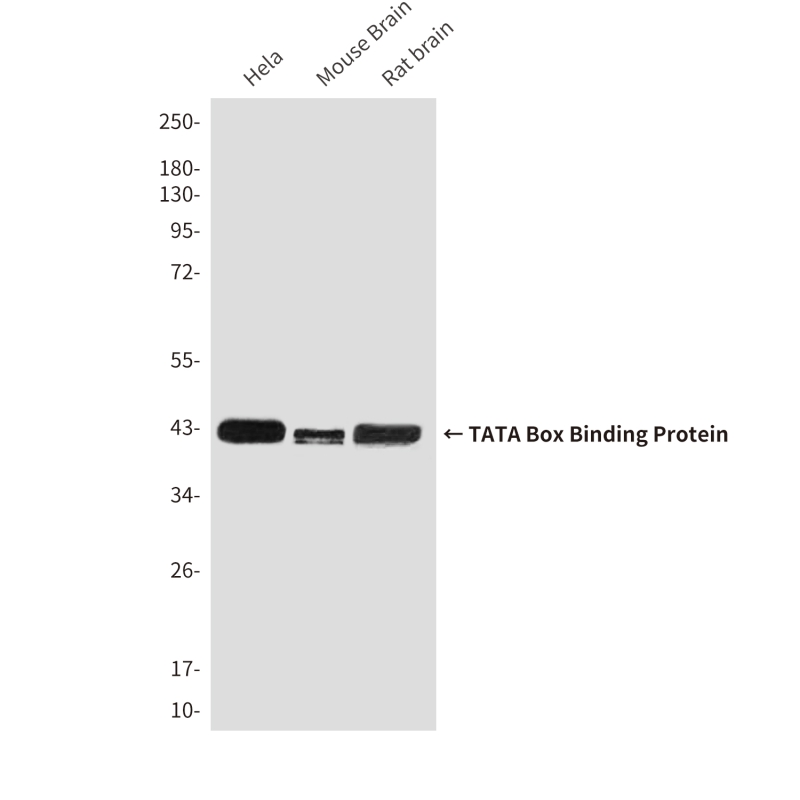
| WB | 咨询技术 | Human,Mouse,Rat |
| IF | 咨询技术 | Human,Mouse,Rat |
| IHC | 咨询技术 | Human,Mouse,Rat |
| ICC | 技术咨询 | Human,Mouse,Rat |
| FCM | 咨询技术 | Human,Mouse,Rat |
| Elisa | 咨询技术 | Human,Mouse,Rat |
| Aliases | TBP; GTF2D1; TF2D; TFIID; TATA-box-binding protein; TATA sequence-binding protein; TATA-binding factor; TATA-box factor; Transcription initiation factor TFIID TBP subunit |
| Entrez GeneID | 6908 |
| clone | 9G1 |
| WB Predicted band size | Calculated MW: 38 kDa; Observed MW: 35-45 kDa |
| Host/Isotype | Mouse IgG1 |
| Antibody Type | Primary antibody |
| Storage | Store at 4°C short term. Aliquot and store at -20°C long term. Avoid freeze/thaw cycles. |
| Species Reactivity | Human,Mouse,Rat |
| Immunogen | Purified recombinant protein expressed in E.coli. |
| Formulation | Purified antibody in PBS with 0.05% sodium azide,0.5%BSA and 50% glycerol. |
+ +
以下是关于TATA Box Binding Protein(TBP)抗体的3篇代表性文献示例,格式为文献名称、作者及简要摘要概括:
---
1. **"A monoclonal antibody against human TATA-binding protein reveals differential subcellular distribution of transcription complexes"**
*Authors: Weinzierl RO, Dynlacht BD, Tjian R*
摘要:该研究开发了一种特异性识别人类TBP的单克隆抗体,用于分析不同转录复合物在细胞核内的定位差异,证实TBP在RNA聚合酶II和III的转录起始中具有动态分布特征。
2. **"TBP-binding protein antibodies in autoimmune diseases: implications for transcriptional dysfunction"**
*Authors: Zhang L, et al.*
摘要:探讨了自身免疫性疾病患者血清中抗TBP抗体的存在及其对基因转录的干扰作用,揭示了这类抗体可能通过破坏TBP与DNA的结合导致转录异常。
3. **"Characterization of a polyclonal antibody targeting the conserved core domain of TATA-box binding protein"**
*Authors: Martinez E, et al.*
摘要:报道了一种针对TBP高度保守结构域的多克隆抗体制备方法,验证了其在Western blot、免疫沉淀及染色质免疫共沉淀(ChIP)中的高特异性和灵敏度,为转录机制研究提供工具。
---
*注:以上文献信息为示例性概括,具体研究请以实际发表的论文内容为准。如需真实文献,建议通过PubMed或Google Scholar检索关键词(如"TBP antibody applications")。*
The TATA-box binding protein (TBP) is a critical transcription factor involved in RNA polymerase II-dependent gene expression. As a core component of the TFIID complex, TBP binds to the TATA box, a conserved DNA sequence motif (TATAWAW) in gene promoters, facilitating the assembly of the pre-initiation complex and transcription initiation. Structurally, TBP contains a highly conserved C-terminal domain with a saddle-shaped structure for DNA binding and a variable N-terminal domain that interacts with other transcription factors.
Antibodies targeting TBP are essential tools for studying transcriptional regulation. They are widely used in techniques like Western blotting, chromatin immunoprecipitation (ChIP), and immunofluorescence (IF)/immunohistochemistry (IHC) to detect TBP expression, localization, and DNA-binding activity. These antibodies help elucidate TBP's role in cellular processes, including cell cycle regulation, differentiation, and stress responses. Additionally, they aid in investigating dysregulated TBP function in diseases such as cancer, neurodegenerative disorders, and developmental abnormalities.
Commercial TBP antibodies are typically raised against conserved regions (e.g., human TBP residues 1-160 or 180-320) and validated for species cross-reactivity (human, mouse, rat). Controls using TBP-deficient cells or competitive peptides are recommended to ensure specificity. Research utilizing TBP antibodies continues to advance understanding of transcriptional mechanisms and therapeutic targeting of aberrant gene expression.
×